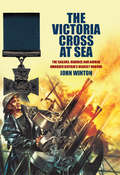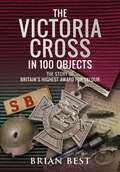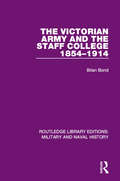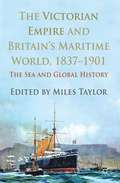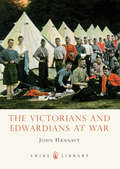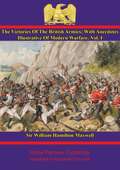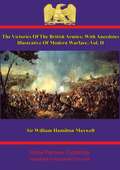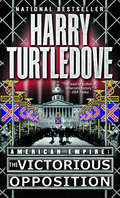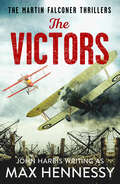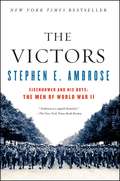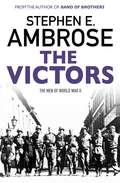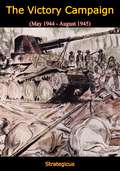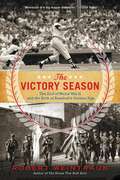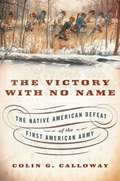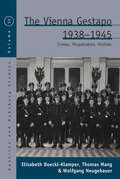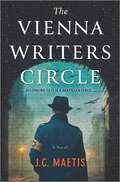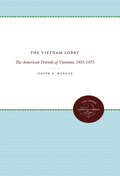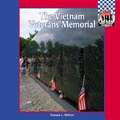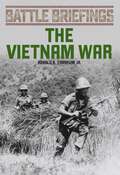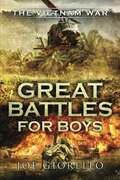- Table View
- List View
The Victoria Cross at Sea: The Sailors, Marines and Airmen Awarded Britain's Highest Honour
by John WintonNaval VCs have been won in places as far apart in time and distance as the Baltic in 1854 and Japan in 1945, in the trenches from the Crimea to the Western Front, in harbours from Dar es Salaam to Zeebrugge, from the Barents to the Java Sea, from New Zealand to the North Atlantic, and from China to the Channel. They have been won in battleships and trawlers, in submarines below the water and aircraft above it, on horseback and on foot.Age and rank meant nothing. Boy Cornwall was not seventeen at Jutland, and Frederick Parslow was in his sixtieth year when he earned his VC on board a horse transport ship. William Hall was the son of a freed slave; Charles Lucas, awarded the Royal Navys first VC, became a Rear Admiral. Neither were all the recipients of Britains highest gallantry decoration British, and men from Canada, Australia and New Zealand were included in those whose actions were recognised by the awarding of the VC. Yet every one of them had one thing in common uncommon valour.
The Victoria Cross in 100 Objects: The Story of the Britain’s Highest Award For Valour
by Brian BestIt was the events of the Crimean War that changed everything. Until that time, those serving in Britain’s army or navy had been expected to do their duty without thought of recognition or reward, particularly the men in the lower ranks. Fueled by reports from the first ever war correspondents, which were read by an increasingly literate public, the mumblings of discontent over how the gallantry and valor of the ordinary man was recognized rapidly grew into a national outcry. Questions were asked in Parliament, answers were demanded by the press – why were the heroes of the Alma, Inkerman and the Charge of the Light Brigade not being officially acknowledged? Something had to be done. That something was the introduction of an award that would be of such prestige it would be sought by all men from the most junior private to a Field Marshal. It would be the highest possible award for valor in the face of the enemy and it bore the name of the Queen for whom the men fought – The Victoria Cross. Since the VC was instituted in January 1856, it has been awarded 1,358 times to 1,355 individual recipients. Those men were thrown into wars and campaigns around the globe, from the seas and skies around the UK to the deserts of Africa and the sweltering jungles of the Far East. The two world wars saw the most VCs awarded – 628 in the First and 182 in the Second. Only fifteen medals, eleven to members of the British Army, and four to the Australian Army, have been awarded since the Second World War. In this highly-illustrated work, the renowned Victoria Cross historian and author Brian Best examines the introduction and evolution of the VC, along with some of the fascinating individuals and remarkable acts of valor associated with it, through an intriguing collection of 100 objects.
The Victorian Army and the Staff College 1854-1914 (Routledge Library Editions: Military and Naval History #6)
by Brian BondA pioneering work in British military history, originally published in 1972, this book is both scholarly and entertaining. Although the book concentrates on a single institution, it illuminates a much wider area of social and intellectual change. For the Army the importance of the change was enormous: in 1854 there was neither a Staff College nor a General Staff, and professional education and training were largely despised by the officers: by 1914 the College could justly be described as ‘a school of thought’ while the officers it had trained were coming to dominate the highest posts in Commands and on the General Staff.
The Victorian Empire and Britain’s Maritime World, 1837–1901: The Sea and Global History
by Miles TaylorA wide-ranging new survey of the role of the sea in Britain's global presence in the 19th century. Mostly at peace, but sometimes at war, Britain grew as a maritime empire in the Victorian era. This collection looks at British sea-power as a strategic, moral and cultural force.
The Victorians and Edwardians at War
by John HannavyBy the time the first photographs were taken at war in the late 1840s, the idea that 'the camera cannot lie' was already firmly embedded in the Victorian psyche. 'Truthful' in a way the work of the war artist could never be, despite the initially long exposures and cumbersome equipment, cameras have been used to document war ever since the celebrated photographs of Roger Fenton in the Crimea. Through a rich selection of images - many of them never before published - this book tells the story of the photographers who chronicled Britain's Victorian and Edwardian wars and those who fought in them.
The Victories Of The British Armies — Vol. I: With Anecdotes Illustrative Of Modern Warfare. By the author of "Stories of Waterloo". (The Victories Of The British Armies #1)
by Sir William Hamilton MaxwellThe British Army gained a coalesced identity and a European reputation from its exploits in the Peninsular War against the much vaunted French army. A veteran of the fighting himself, Sir William recounts the exploits and deeds of the British army from the battle-fields strewn across Portugal and Spain. Written in rollicking style, the anecdotes of Barossa, Vimiero, Talavera, Fuentes D'Oñoro, Salamanca and Vittoria still remain of fresh interest to this day.Sir William Hamilton Maxwell was a Scots-Irish novelist, noted for his many works in both fiction and non-fiction, and a frequent contributor to the periodicals of the time. His three-volume biography of the Duke of Wellington and his stories of Waterloo are still quoted as authoritative today.This first volume brings the action from 1808 to 1812.Author -- Maxwell, Sir William Hamilton, 1792-1850.Text taken, whole and complete, from the edition published in London, Henry G. Bohn, 1847. Original Page Count - xi and 406 pages.
The Victories Of The British Armies — Vol. II: With Anecdotes Illustrative Of Modern Warfare. By the author of "Stories of Waterloo". (The Victories Of The British Armies #2)
by Sir William Hamilton MaxwellThe British Army gained a coalesced identity and a European reputation from its exploits in the Peninsular War against the much vaunted French army. A veteran of the fighting himself, Sir William recounts the exploits and deeds of the British army from the battle-fields strewn across Portugal and Spain. Written in rollicking style, the anecdotes of Barossa, Vimiero, Talavera, Fuentes D'Oñoro, Salamanca and Vittoria still remain of fresh interest to this day.Sir William Hamilton Maxwell was a Scots-Irish novelist, noted for his many works in both fiction and non-fiction, and a frequent contributor to the periodicals of the time. His three-volume biography of the Duke of Wellington and his stories of Waterloo are still quoted as authoritative today.This second volume picks up the narrative after the battle of Salamanca in 1812 to the end of the war.Author -- Maxwell, Sir William Hamilton, 1792-1850.Text taken, whole and complete, from the edition published in London, Henry G. Bohn, 1847. Original Page Count - 402 pages.
The Victorious Opposition (The American Empire #3)
by Harry TurtledoveHarry Turtledove's acclaimed alternate history series began with a single question: What if the South had won the Civil War? Now, seventy years have passed since the first War Between the States. The North American continent is locked in a battle of politics, economies, and moralities. In a world that has already felt the soul-shattering blow of the Great War, North America is the powder keg that could ignite another global conflict--complete with a new generation of killing machines. "Freedom! Freedom! Freedom!" In 1934, the chant echoes across the Confederate States of America, a country born of bloodshed and passion, stretching from Mexico to Virginia. But while people use the word to greet each other in the streets, the meaning of "Freedom" has become increasingly unclear. Jake Featherston, leader of the ruling Freedom Party, has won power--and is taking his country and the world to the edge of an abyss. Charismatic, shrewd, and addicted to conflict, Featherston is whipping the Confederate States into a frenzy of hatred. Blacks are being rounded up and sent to prison camps, and the persecution has just begun. Featherston has forced the United States to give up its toeholds in Florida and Kentucky, and as the North stumbles through a succession of leaders, from Socialist Hosea Blackford to Herbert Hoover and now Al Smith, Featherston is feeling his might. With the U. S. A. locked in a bitter, bloody occupation of Canada, facing an intractable rebellion in Utah, and fatigued from a war in the Pacific against Japan, Featherston may pursue one dangerous proposition above all: that he can defeat the U. S. A. in an all-out war. The Victorious Opposition is a drama of leaders and followers, spies and traitors, lovers and soldiers. From California to Canada, from combat on the high seas to the secret meetings where former slaves plot a desperate strategy for survival, Harry Turtledove has created a human portrait of a world in upheaval. The third book in his monumental American Empire series, The Victorious Opposition is a novel of ideas, action, and surprise--and an unforgettable re-imagining of history itself.
The Victors (Martin Falconer Thrillers)
by Max HennessyMartin Falconer had one big anxiety: would they let him fly again?Grounded in England at the beginning of 1918, it was a struggle, for escaped prisoners of war weren’t generally allowed to return to the front, but Martin pestered the authorities and, at last, found himself back in France.But the character of the war was changing. Everyone had suddenly become efficiency-conscious, and the freedom of choice which he had valued so much in his life as a pilot was disappearing. Martin had to settle down to the grim, monotonous business that aerial warfare had now become.It was work that took a terrible toll on the nerves, even of someone as young and strong as he was. He longed to be able to solve the problem, and for the war to be over, so that he could start to find out what he really wanted from life.A gripping story, totally convincing in its portrayal of the ordeals and rewards of flying in the First World War, for fans of Alexander Fullerton and W. E. Johns.
The Victors: Eisenhower And His Boys The Men Of World War Ii
by Stephen E. AmbroseFrom America’s preeminent military historian, Stephen E. Ambrose, comes the definitive telling of the war in Europe, from D-Day, June 6, 1944, to the end, eleven months later, on May 7, 1945.This authoritative narrative account is drawn by the author himself from his five acclaimed books about that conflict, most particularly from the definitive and comprehensive D-Day and Citizen Soldiers, about which the great Civil War historian James McPherson wrote, “If there is a better book about the experience of GIs who fought in Europe during World War II, I have not read it. Citizen Soldiers captures the fear and exhilaration of combat, the hunger and cold and filth of the foxholes, the small intense world of the individual rifleman as well as the big picture of the European theater in a manner that grips the reader and will not let him go. No one who has not been there can understand what combat is like but Stephen Ambrose brings us closer to an understanding than any other historian has done.” The Victors also includes stories of individual battles, raids, acts of courage and suffering from Pegasus Bridge, an account of the first engagement of D-Day, when a detachment of British airborne troops stormed the German defense forces and paved the way for the Allied invasion; and from Band of Brothers, an account of an American rifle company from the 506th Parachute Infantry Regiment who fought, died, and conquered, from Utah Beach through the Bulge and on to Hitter's Eagle’s Nest in Germany. Stephen Ambrose is also the author of Eisenhower, the greatest work on Dwight Eisenhower, and one of the editors of the Supreme Allied Commander's papers. He describes the momentous decisions about how and where the war was fought, and about the strategies and conduct of the generals and officers who led the invasion and the bloody drive across Europe to Berlin. But, as always with Stephen E. Ambrose, it is the ranks, the ordinary boys and men, who command his attention and his awe. The Victors tells their stories, how citizens became soldiers in the best army in the world. Ambrose draws on thousands of interviews and oral histories from government and private archives, from the high command—Eisenhower, Bradley, Patton—on down through officers and enlisted men, to re-create the last year of the Second World War when the Allied soldiers pushed the Germans out of France, chased them across Germany, and destroyed the Nazi regime.
The Victors: The Men of WWII
by Stephen E. AmbroseThe Victors is a breathtaking new work from bestselling historian Stephen E. Ambrose, author of the classic book Band of Brothers. It follows the momentous events of the Second World War from D-Day, 6 June 1944, through to the final days when the Allied soldiers pushed the German troops out of France, chased them across Germany. Finally, on VE Day, 7 May 1945, they could celebrate the destruction of the Nazi regime as victory in Europe was secured. At the centre of this epic drama are the citizen soldiers, the boys who became men as they fought, eventually proving unbeatable. Drawing from his extensive research for his previous bestselling books on the conflict, Ambrose creates one of the most exciting single-volume histories of World War II ever written. The Victors is a compelling celebration of military genius and heroism, and of camaraderie and courage.
The Victory Campaign (May 1944 - August #1945)
by StrategicusOriginally published in 1947, “This volume is the last of the series in which I have attempted to write the history of the war while it is actually taking place. It does not appear during the war for the best of reasons; but it is unduly late because of a number of personal mischances and because it covers much more ground than the earlier volumes. The battle-piece it attempts to portray is, in fact, the greatest in the history of the world. Never before have campaigns of the size and scope taken place. In the numbers engaged, in the amount of material used, in distances covered, in the novelty of the tactics and in the almost incredible brutality of some of the methods used, the campaigns of this period from May 1944 to the middle of August 1945 are unique.”Richly illustrated throughout with maps.
The Victory Dogs
by Megan RixThe Victory Dogs is the incredible story of two puppies who become heroes of the blitz.A heartwarming story for 9+ readers who are fans of Michael Morpurgo's War Horse and Lauren St John. BARK and HOWL are two puppies, born on the London undergroundSHEBA is an elderly one-eared catWhen the Blitz begins, how will they survive?It's the start of the Second World War and Bark and Howl are lost in the dark maze of tunnels under London.With Sheba's help, they learn how to survive. But when the bombs begin to fall, the puppies become separated. As the attacks continue, Bark and Howl are frightened, but they know the tunnels so well - they're the only ones who can lead hundreds of trapped people out of danger. Will Bark and Howl find each other - and be victorious in leading Londoners to safety?'If you love Michael Morpurgo, you will enjoy this' Express 'A moving tale told with warmth, kindliness and lashings of good sense that lovers of Dick King-Smith will especially appreciate' The Times'Every now and then a writer comes along with a unique way of storytelling . . . Meet Megan Rix . . . her novels are deeply moving and will strike a chord with animal lovers.' LoveReadingAbout the author:Megan Rix lives in England with her husband, and their adorable dogs, Traffy and Bella. Also available by Megan Rix:The Great Escape
The Victory Season: The End of World War II and the Birth of Baseball's Golden Age
by Robert WeintraubIn the spring of 1946, Americans were ready to heal. World War II was finally over, and hundreds of baseball's stars were coming home. Players like Ted Williams, Stan Musial, and Joe Dimaggio returned to the Majors with bats blazing, making the season one of the most memorable in history, capped with a thrilling seven-game World Series. And a new era began, with Jackie Robinson making his professional debut. Robert Weintraub brings to life little-known tales from the war years, including the "world series" servicemembers played in an abandoned Hitler Youth stadium in the fall of 1945. Once home, returning players set attendance records in a season that kicked off baseball's golden era. In THE VICTORY SEASON, Weintraub's in-depth research and storytelling talent enliven one of the sport's greatest periods.Europe in an attempt to experience just a bit of home. From the little-known "world series" services members played in the European theater in the fall of 1945 to the poignant stories of the only two major leaguers to die in the war, Robert Weintraub brings his in-depth research and signature storytelling talent to one of the sport's greatest seasons.
The Victory With No Name: The Native American Defeat Of The First American Army
by Colin G. CallowayIn 1791, General Arthur St. Clair led the United States army in a campaign to destroy a complex of Indian villages at the Maumee River in northwestern Ohio. Almost within reach of their objective, St. Clair's 1,400 men were attacked by about one thousand Indians. The U. S. force was decimated, suffering nearly one thousand casualties in killed and wounded, while Indian casualties numbered only a few dozen. But despite the lopsided result, it wouldn't appear to carry much significance; it involved only a few thousand people, lasted less than three hours, and the outcome, which was never in doubt, was permanently reversed a mere three years later. Neither an epic struggle nor a clash that changed the course of history, the battle doesn't even have a name. Yet, as renowned Native American historian Colin Calloway demonstrates here, St. Clair's Defeat--as it came to be known-- was hugely important for its time. It was both the biggest victory the Native Americans ever won, and, proportionately, the biggest military disaster the United States had suffered. With the British in Canada waiting in the wings for the American experiment in republicanism to fail, and some regions of the West gravitating toward alliance with Spain, the defeat threatened the very existence of the infant United States. Generating a deluge of reports, correspondence, opinions, and debates in the press, it produced the first congressional investigation in American history, while ultimately changing not only the manner in which Americans viewed, raised, organized, and paid for their armies, but the very ways in which they fought their wars. Emphasizing the extent to which the battle has been overlooked in history, Calloway illustrates how this moment of great victory by American Indians became an aberration in the national story and a blank spot in the national memory. Calloway shows that St. Clair's army proved no match for the highly motivated and well-led Native American force that shattered not only the American army but the ill-founded assumption that Indians stood no chance against European methods and models of warfare. An engaging and enlightening read for American history enthusiasts and scholars alike, The Victory with No Name brings this significant moment in American history back to light.
The Victory: The Morland Dynasty, Book 12 (Morland Dynasty #12)
by Cynthia Harrod-Eagles1803: Napoleon is poised to invade England, with only Nelson's weather-beaten ships in his way, but the French fleet are not the only threat to the fortunes of the Morland family.In the North of England, Mary Ann's relationship with the missionary, Father Rathbone, introduces her to the stark realities of life in plague-torn Manchester.In the South, Lucy's lover, Weston, is assigned to the blockade of Brest, while her neglected husband, Chetwyn, finally finds love in an affair which threatens him with disgrace and ruin.From the fashionable salons of Beau Brummell's London, to the shot-torn docks at Trafalgar, the Morlands face danger and personal tragedy, as well as love and fulfilment.
The Victory: The Morland Dynasty, Book 12 (Morland Dynasty #12)
by Cynthia Harrod-Eagles1803: Napoleon is poised to invade England, with only Nelson's weather-beaten ships in his way, but the French fleet are not the only threat to the fortunes of the Morland family.In the North of England, Mary Ann's relationship with the missionary, Father Rathbone, introduces her to the stark realities of life in plague-torn Manchester. In the South, Lucy's lover, Weston, is assigned to the blockade of Brest, while her neglected husband, Chetwyn, finally finds love in an affair which threatens him with disgrace and ruin.From the fashionable salons of Beau Brummell's London to the shot-torn docks at Trafalgar, the Morlands face danger and personal tragedy, as well as love and fulfilment.
The Vienna Gestapo, 1938-1945: Crimes, Perpetrators, Victims (Austrian and Habsburg Studies #33)
by Elisabeth Boeckl-Klamper Thomas Mang Wolfgang NeugebauerThe Vienna Gestapo headquarters was the largest of its kind in the German Reich and the most important instrument of Nazi terror in Austria, responsible for the persecution of Jews, suppression of resistance and policing of forced labourers. Of the more than fifty thousand people arrested by the Vienna Gestapo, many were subjected to torturous interrogation before being either sent to concentration camps or handed over to the Nazi judiciary for prosecution. This comprehensive survey by three expert historians focuses on these victims of repression and persecution well as the structure of the Vienna Gestapo and the perpetrators of its crimes.
The Vienna Gestapo, 1938-1945: Crimes, Perpetrators, Victims (Austrian and Habsburg Studies)
by Elisabeth Boeckl-Klamper Thomas Mang Wolfgang NeugebauerThe Vienna Gestapo headquarters was the largest of its kind in the German Reich and the most important instrument of Nazi terror in Austria, responsible for the persecution of Jews, suppression of resistance and policing of forced labourers. Of the more than fifty thousand people arrested by the Vienna Gestapo, many were subjected to torturous interrogation before being either sent to concentration camps or handed over to the Nazi judiciary for prosecution. This comprehensive survey by three expert historians focuses on these victims of repression and persecution as well as the structure of the Vienna Gestapo and the perpetrators of its crimes.
The Vienna Writers Circle: A Historical Fiction Novel
by J. C. MaetisA gripping and powerful tale of resilience and courage set in Vienna on the brink of WWII, as two members of Freud&’s Circle try to keep themselves and their loved ones safe as the SS closes in.Spring, 1938: Café Mozart in the heart of Vienna is beloved by its clientele, including cousins Mathias Kraemer and Johannes Namal. The two writers are as close as brothers. They are also members of Freud&’s Circle—a unique group of the famed psychiatrist&’s friends and acquaintances who once gathered regularly at the bright and airy café to talk about books and ideas over coffee and pastries. But dark days are looming. With Hitler&’s annexation of Austria, Nazi edicts governing daily life become stricter and more punitive. Now Hitler has demanded that the &“hidden Jews&” of Vienna be tracked down, and Freud&’s Circle has been targeted. The SS aims to use old group photos to identify Jewish intellectuals and subversives. With the vise tightening around them, Mathias and Johannes&’s only option appears to be hiding in plain sight, using assumed names and identities to evade detection, aware that discovery would mean consignment to a camp or execution. Faced with stark and desperate choices, Mathias, Johannes, their families and friends all find their loyalties and courage tested in unimaginable ways. But despite betrayal, heartache and imprisonment, hope remains, and with it, the determination to keep those they love alive, and Mathias and Johannes at the same time discovering that what originally condemned them—their writing—might also be their salvation.
The Vietnam Lobby: The American Friends of Vietnam, 1955-1975
by Joseph G. MorganEstablished in 1955 as a private advocacy group, the American Friends of Vietnam worked to influence U.S. attitudes and policies toward Vietnam for nearly two decades. AFV members wrote articles, gave speeches, sponsored aid drives, and forged ties with journalists, academics, and government officials in an effort to generate American assistance for South Vietnam. In The Vietnam Lobby, Joseph Morgan shifts the focus away from the much-examined antiwar demonstrations that took place in America to concentrate instead on the actions of those who endorsed U.S. intervention in Vietnam. Drawing on a wide range of documentary sources, Morgan presents a comprehensive study of the AFV and its activities. He traces the group's establishment and growth, examines its internal organization and politics, and, ultimately, evaluates its effectiveness in guiding government policy and public opinion. Morgan also assesses the charges of antiwar critics who claimed the AFV exerted an excessive, perhaps disastrous, influence in shaping America's Vietnam policy. Finally, he offers insights into the thinking of those who believed that the United States had the unique ability--even the obligation--to help shape Vietnam's future.Originally published in 1997.A UNC Press Enduring Edition -- UNC Press Enduring Editions use the latest in digital technology to make available again books from our distinguished backlist that were previously out of print. These editions are published unaltered from the original, and are presented in affordable paperback formats, bringing readers both historical and cultural value.
The Vietnam Veterans Memorial
by Tamara L. BrittonProvides background information on the Vietnam War and on the memorial that was built to honor those who died during this conflict.
The Vietnam War
by Nextext Staff Mcdougal-Littell Publishing StaffThis Nextext Historical Reader documents how the United States became progressively embroiled in Viet Nam—first as military advisors to the French (who called Viet Nam “Indochina”), then as backers of the unpopular Diem regime—to the final extrication from Viet Nam, the fall of Saigon.
The Vietnam War (Battle Briefings)
by Ronald B. Frankum Jr.The latest entry in Stackpole&’s Battle Briefings Series covers the Vietnam War, from its roots in the French war through the evacuation of the embassy. In between is the American Vietnam experience: the draft, the combat, the politics, and everything else. Here, in 176 pages, is the Vietnam War.
The Vietnam War (Great Battles for Boys)
by Sibella Giorello Joe GiorelloFrom first-person accounts to front-line battlefield action reports, boys will learn about the Vietnam War, including the politics that sent American soldiers into this deadly and disastrous conflict. <p><p> Written in an engaging style and with dozens of historical photos, Great Battles for Boys captivates even the most reluctant readers. Boys learn about the military strategies, tactics, and weapons that won (or lost) the most significant battles of world history. <p><p> Boys also learn about the difference between democracy and Communism, and how that difference helped fuel the United States’ entry into another country's civil war.
